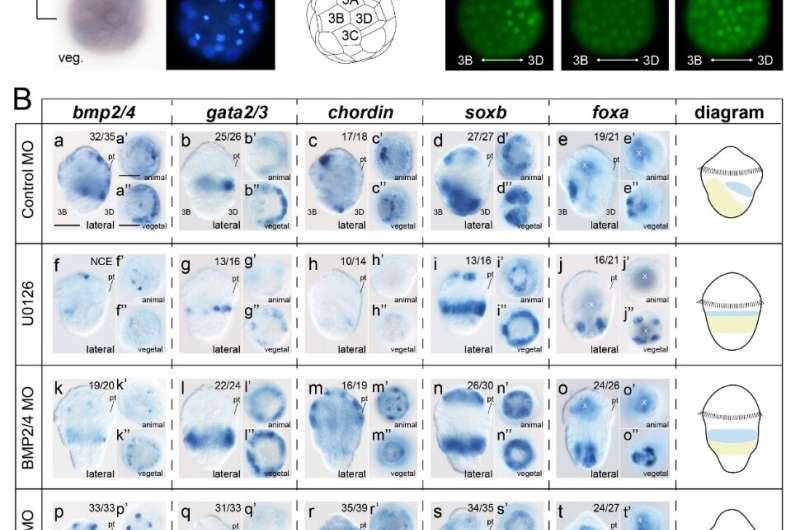Dorsal-ventral patterning mechanism provides insights into unique developmental mode and evolution of spiralians

The formation of the dorsal-ventral (DV) axis is one of the most important events during the early development of bilaterian animals. It is widely accepted that a conserved molecular logic (BMP2/4 and Chordin) regulates tissue differentiation along the DV axis.
Such DV patterning mechanism has been revealed in a wide range of bilaterian animals. However, this mechanism exhibits a considerable degree of variations in Spiralia, one of the three major clades of bilaterians.
A research team led by Prof. Liu Baozhong from the Institute of Oceanology of the Chinese Academy of Sciences (IOCAS) has revealed the roles of BMP2/4 and Chordin in the DV patterning of the equal cleaving gastropod mollusk Lottia goshimai, which is the first report that the conserved DV patterning mechanism relying on BMP2/4 and Chordin exists in Spiralia.
The study was published in Molecular Biology and Evolution.
The researchers found that the conserved molecular logic BMP2/4 and Chordin were deeply integrated into the organizer function in spiralian development, which then mediated the DV patterning process.
Knocking down any one of the two genes caused the failure to form a BMP signaling gradient in early embryos, which marked a loss of function of the organizer. These embryos could not form a DV axis and featured organs in subsequent development, which reveals the crucial roles of the two genes in DV patterning as well as organizer function.
Moreover, the study provides evidence that the DV patterning is likely connected to essential developmental events such as the blastoporal behavior and organization of the nervous system.
The researchers found that the embryos with impaired DV patterning all possessed posteriorized blastopore, showing sharp contrast with the normal ventrally-localized blastopore. The featured bilaterally symmetrical nervous system was also seriously disturbed, exhibiting a high degree of disorganization.
Given that the formation of a ventral blastopore and a bilaterally-organized nervous system is considered essential features of bilaterians, these results may indicate coordinated transitions of the two developmental events with the origin of the DV axis in animals.
These results provide insights into the unique developmental mode and the evolution of spiralians.
More information: Sujian Tan et al, Molluscan dorsal-ventral patterning relying on BMP2/4 and Chordin provides insights into spiralian development and evolution, Molecular Biology and Evolution (2021). DOI: 10.1093/molbev/msab322
Journal information: Molecular Biology and Evolution
Provided by Chinese Academy of Sciences


















